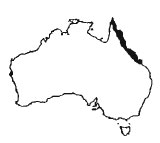Varanus Semiremex
Peters 1869Rusty goanna
 |
This enigmatic little goanna reaches a maximum size of about 60cm TL. James et al (1992) give a maximum size of 27cm SYL and consider sexual maturity to be attained around 15cm SYL. Mertens (1961) reports a length of 23.5cm SYL (over 66cm TL) for his specimen from Westem Australia. Swanson (1976) gives a maximum size of 75cm TL. Six specimens examined by Dunson (1974) weighed 150 - 294g. Bustard (1970) records collecting rusty goannas from seasonally tlooded mangroves around Townsville. as does Dunson (1974). Hedley (in knghorn 1924a) found one running along a beach. Its favourite food appears to be crabs (Dunson 1974; Swanson 1976; Losos & Greene 1988; James et al 1992). Other prey include frogs. fish and insects. All prey found by James et al (1992) were aquatic in origin but Dunson (1974) suggested that small mammals are also included in the diet. The rusty goanna appears to be an arboreal species which lives in hollows and on branches of trees overhanging the water. According to Dunson. in the mangroves around Townsville they forage over exposed mudtlats at low tide. This species is equipped with a salt gland that senetes sodium. chlorides and potassium, enabling lizards from saltwater environments to obtain all their freshwater by eating blackish-water prey. Examination of museum specimens led James et al (1992) to conclude that breeding occurs in the late wet season (between February and April). The only gravid specimen examined by them contained two eggs, but clutches can contain as many as 14 eggs (Horn in James et al 1992). Ritual combat of the rusty monitor is described by Horn (1985). Opponents lie vent to veint grasping each other with all four legs and attempt to flick each other over in the typical Odatrian manner
Little is known about the captive care of this species in captivity. the only published accounts being those of Peters (1968, 1969cc) and Pollock (1982). They should be kept warm and provided with a large terrarium with plenty of branches to climb on and a pool of water at least large enough for the lizards to immerse themselves. They are said to be very peaceful and tame in captivity and will eat small mammals, birds and eggs as well as their usual aquatic prey.
Attribution / Courtesy: Daniel Bennett. 1995. A Little Book of Monitor Lizards. Viper Press U.K.




